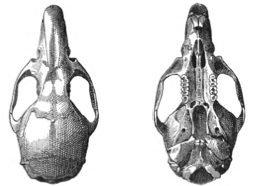Talamancan oryzomys facts for kids
Quick facts for kids Talamancan oryzomys |
|
|---|---|
 |
|
| Skull of the holotype, a young adult female from Boquete, Panama. | |
| Conservation status | |
| Scientific classification | |
| Genus: |
Nephelomys
|
| Species: |
devius
|
| Synonyms | |
|
Oryzomys devius Bangs, 1902 |
|
The Nephelomys devius, also called the Talamancan rice rat, is a small rodent. It's a type of rat found in the cool, misty cloud forests. You can find it high up in the mountains of Costa Rica and western Panama.
Contents
What Does the Talamancan Rice Rat Look Like?
This rice rat has light brown fur on its back. The fur gets lighter as it goes down its sides. Its belly is a creamy white color, and it has a white patch on its throat.
Its ears and nose are dark, almost black. Its feet can be yellow or brown. The tail is dark brown on top and a bit lighter underneath. Young rats have darker fur on their backs than adults.
How Big Are They?
These rats are medium-sized. From nose to tail tip, they are about 33.5 to 36 centimeters (about 13 to 14 inches) long. Their tail alone is about 18 to 19.5 centimeters (about 7 to 7.7 inches) long. Their back feet are about 3.3 to 3.6 centimeters (about 1.3 to 1.4 inches) long.
Where Do They Live?
The Talamancan rice rat lives in the western parts of its genus's range. This means it's the most western type of Nephelomys rat. Another similar species, N. pirrensis, lives further east in Panama.
How Was This Rat Discovered?
The Talamancan rice rat was first described in 1902. It was originally named Oryzomys devius. Scientists thought it was related to another rat called O. meridensis.
For a while, in 1966, it was grouped with Oryzomys albigularis. But later, scientists decided it was its own unique species again. In 2006, all these related rats were moved into a new group called Nephelomys. So, since then, it has been known as Nephelomys devius.


